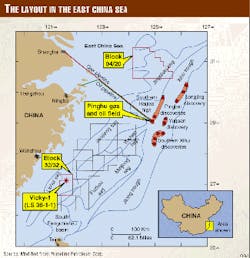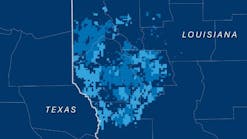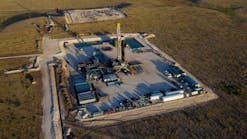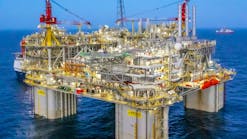China appears keen to step up gas exploration and production in the East China Sea, where it brought the first field on production earlier this year.
China Offshore Donghai Oil Co., Shanghai, a local affiliate of China National Offshore Oil Corp., hopes to have established production of 100-175 MMcfd of gas from the East China Sea by 2010, China Petroleum Newsletter reported. Codoc started up Pinghu gas and oil field in the Xihu trough in April 1999.
Pinghu field started up in April at about 14 MMcfd, which is being transported via 250 mile pipeline to 3,600 households in the Beicai district of Pudong in Shanghai. That is to ramp up to 42 MMcfd by April 2000, with production continuing for 10-15 years. One report is that Pinghu oil production began in December 1998, but volumes are not known.
Field size is 240 sq km, of which first stage development involves 20 sq km. Water depth is 287 ft.
Chinese entities have made numerous discoveries in the Xihu trough seaward of Pinghu field. Foreign operators drilling to the southwest on 1993 licensing round acreage encountered shows in numerous wells, but only one, Vicky-1, was termed potentially commercial.
Its operator, Primeline Petroleum Corp., London, has shot a 3D seismic over the Vicky well and surrounding area. All other blocks in that area shown on the accompanying map were relinquished prior to the drilling of the Vicky prospect.
Primeline, as the only non-Chinese operator in the East China Sea, now holds blocks 32/32 and 04/20 at opposite ends of the prospective trend.
Marine Paleocene play
The Vicky well proved the source and reservoir potential of the marine Paleocene sequence in the Lingfeng formation in one part of the East China Sea basin system, Primeline told the Seapex Exploration Conference in Singapore last December.
This marine Paleocene sequence extends northeastwards from Block 32/32 throughout the Lishui and Jiaojiang sags (sub-basins), reported authors Alan Soulsby of Exploration Consultants Ltd., Henley, U.K., and Dr. G.M. Wang of Primeline. The sequence covers more than 10,000 sq km with a sediment volume in excess of 15 trillion cu m.
Primeline drilled Vicky-1 (LS 36-1-1), a potentially commercial gas discovery 360 km southwest of Pinghu field and 140 km off Wenzhou, in 1997.
"This is a four-way dipping anticlinal structure located on the down-side of the Lingfeng fault above the thickest development of Paleocene section and associated with a seismic amplitude anomaly."
The well drillstem tested 9.86 MMcfd of gas, 117 b/d of hydrocarbon liquids, and 15.7 b/d of water from 33 m of Paleocene Lingfeng sands and shales at about 2,250 m. This interval was part of a 543 m reservoir column. TD is 3,300 m, still in Lingfeng.
Reservoir core and log porosities range 10-16%, and permeabilities are very variable.
Primeline estimated a "most likely" 660 bcf of gas and 7.9 million bbl of condensate reserves in this well with as much as 4.4 tcf of gas plus associated liquids if appraisal and a number of nearby prospects and leads within 20 km of Vicky were included.
Operators had relinquished all adjoining acreage by the time Primeline spudded the well in 1997. Fourteen other wells gave the picture of a nonprospective area, but Vicky proved the existence of an effective petroleum system, the authors wrote.
A well drilled by the Chinese in 1985 about 30 km southwest of Vicky flowed more than 90% carbon dioxide from the Lingfeng formation.
Soulsby and Wang concluded that the hydrocarbon play is at a very immature stage of exploration and "has significant additional exploration potential."
Exploration status
Primeline signed contracts with Cnooc for Block 32/32 in 1994 and Block 04/20 in 1997.
It acquired 233 sq km of 3D seismic data over the Vicky discovery in 1998 and reprocessed a large amount of regional 2D data. About 8,200 km of 2D data are available on the block.
Primeline elected to move to the second exploration phase, effective Mar. 1, 1999, with at least one exploration or appraisal well to be drilled in 2000.
The 3D interpretation resulted in significant additional regional potential and confirmed the previous understanding of the geology of the Vicky discovery.
A required relinquishment on the western side has reduced the initial 6,000 sq km block size to 4,500 sq km.
Gas utilization
Primeline is moving to commercialize the discovery with the city of Wenzhou as the target market.
Wenzhou, population 1.1 million, has experienced economic growth averaging 15%/year the past 20 years, Primeline said. Coal meets most of Zhejiang Province`s energy requirements. Imports from other provinces are inadequate to prevent acute shortfalls in Wenzhou itself.
Primeline in second half 1998 held discussions with several potential gas purchasers and municipal and provincial authorities. It signed a declaration of intent to explore and evaluate the options of gas utilization, including a 600 mw combined cycle gas turbine power plant, a fertilizer plant, or a take-or-pay contract with the Wenzhou government.
Northern block
Primeline holds 100% interest in Block 04/20. Covering 11,820 sq km, it incorporates fourth licensing round blocks 03/06, 10/06, 04/21, and 05/31.
The first exploration phase started Nov. 1, 1997.
Primeline said the block represents a frontier exploration opportunity that has the potential for giant oil discoveries. The block lies in a relatively unexplored part of the proven petroliferous Xihu trough.
The company shot more than 1,000 line km of 2D seismic on the block in 1998 and is finalizing interpretation. It plans to drill an exploration well in 2000. The block`s total 2D seismic data base is about 10,500 km.
Block 04/20 covers the transition zone from the Xihu graben, an Eocene rift basin, and the older Paleocene rift basins farther to the west.
The transition zone is untested, but Primeline has mapped a very large structural closure on the migration pathway from the Xihu graben that has some characteristics similar to the Xihu graben west margin discoveries such as Pinghu field.



